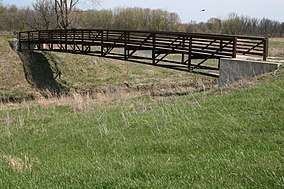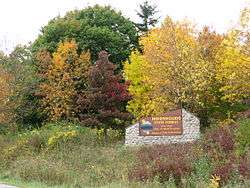Havenwoods State Forest
Havenwoods State Forest is a 237-acre (960,000 m2) property managed by the Wisconsin Department of Natural Resources within the city limits of Milwaukee. The forest was created to provide an urban green space and environmental education center.
| Havenwoods State Forest | |
|---|---|
IUCN category V (protected landscape/seascape) | |
 Pedestrian bridge in Havenwoods | |
  | |
| Location | Milwaukee, Wisconsin, United States |
| Coordinates | 43°7′43″N 87°58′13″W |
| Area | 237 acres (96 ha) |
| Established | 1979 |
| Governing body | Wisconsin Department of Natural Resources |
The land includes grasslands, woods, wetlands, Lincoln Creek, an urban arboretum, and education gardens. The Environmental Awareness Center includes an auditorium, classrooms, displays, and a resource center. There are trails for nature study, hiking, biking, and cross-country skiing. Schoenecker Park abuts the property on the northeast.
Havenwoods is open from 6 a.m. to 8 p.m. daily. A state park vehicle admission sticker is not required to use the park.
History
Havenwoods is a triangle of land that has almost come full circle. In the early 19th century, the land was a swampy forest. Wild animals trekked through the tall trees, followed occasionally by Native Americans in search of food.
In 1836, surveyors walked the land, measuring out a grid that opened this area to settlement. Early settlers included the Zautkes, Pipkorns, Douglases, Bourkes and Schalocks. Being farmers, they cut down the trees, drained the land, and planted crops.
In the early 20th century, Milwaukee County began buying up farmland, needing a new location for its House of Correction, which opened in 1917. The prisoners tended crops, milked cows, and constructed furniture in the Granville Chair Factory. The inspector’s report from 1939 indicates the prison kitchen canned 5534 gallons of tomatoes, 1100 gallons of catsup, 1350 gallons of corn, 172 gallons of rhubarb, and much more that year.[1]
In 1945, the US Army seized the House of Correction for use as an Army Disciplinary Barracks (USDB).[2] The USDB housed soldiers, prisoners of war, and German-American internees. The prison buildings went out of use in the 1950s and were demolished in the 1970s.
In 1956, the Army constructed a Project Nike Ajax missile base at Havenwoods. Altogether, the Army built eight Nike sites, encircling Milwaukee, to protect the city from long-range bombers. By 1958, the Ajax missile was obsolete. The site at Havenwoods was abandoned in 1963.[1]
From about 1950 to 1967, the U.S. Army Reserve used Havenwoods as a training facility. The 84th Division is still located south of Havenwoods on Silver Spring Drive. The city also used parts of the land as a landfill (1958–1970), and homeless families took up residence in the abandoned buildings (1969–1971). [1]
In 1974, the Army decided it no longer needed the land or buildings and declared them surplus. For the first time in 130 years, this 237-acre (0.96 km2) parcel of land on the northwest side of Milwaukee lay abandoned. The prison buildings, tunnels, Nike missile site, and wild grasslands became open to the public.[1]
External links
- Havenwoods State Forest official site
- Friends of Havenwoods
